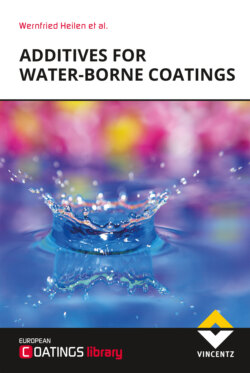Читать книгу Additives for Water-borne Coatings - Wernfried Heilen - Страница 11
На сайте Литреса книга снята с продажи.
2.1.3.1Electrostatic stabilisation
ОглавлениеElectrostatic repulsion is a very important mechanism for stabilising pigment particles in water-borne formulations. This makes use of the Coulombic interactions between similarly charged particles. These interactions can be described by the DLVO theory (named after Derjagin, Landau, Verwey and Overbeek). The wetting and dispersing additive, adsorbed on the pigment surface, dissociates into a polymeric segment, which is anionic, and cationic counter ions. These counter ions are not adsorbed and form a mobile diffuse cloud at the outer edge of the polymeric shell. An electrostatic double layer is created. This leads to repulsion and the particles are stabilised against flocculation.
Electrostatic stabilisation induced by anionic polymeric segments is called anionic stabilisation. Cationic stabilisation can be induced by cationic polymers, in which case anions form a mobile cloud around the particle.
Figure 2.2a: Electrostatic stabilisation
Addition of electrolytes, especially multivalent cations, destabilises the electrostatic double layer, disrupting the balance between anionic polymer and cationic cloud or at least reducing the thickness of the cationic layer. Both lead to a weakening of stabilisation and increase the risk of flocculation.
The zeta potential ζ describes the electrostatic interaction within the polymeric shell. The smaller the numerical value of ζ, the lower is the electrostatic stabilisation. The zeta potential gives no information about steric stabilisation because steric stabilisation does not involve the creation of ions and so no potential can be measured (Figure 2.2a).
It is essential to know what type of stabilisation is employed in the binder system of the target application. If the binder system is cationically stabilised, as in the case of textile printing or leather coatings, the pigment particles should be stabilised in the same way. Otherwise, the pigment particles will flocculate with the binder droplets.
Another important factor is the pH value. A high pH milieu greatly reduces the ability of the wetting and dispersing additive to dissociate and form a cationic cloud. The pKa value of the acid functionality needs to be taken into consideration.
